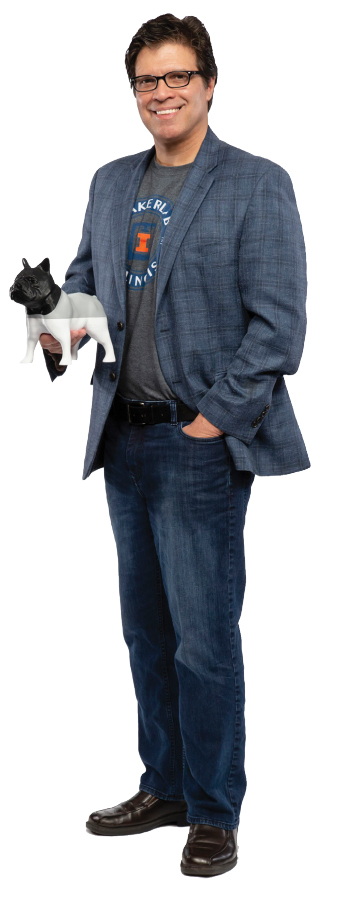In Class: Printers’ Helper
 Aric Rindfleisch, UI professor of marketing, Gies College of Business
Aric Rindfleisch, UI professor of marketing, Gies College of Business The Illinois MakerLab is about five-and-a-half-years old. We began in January 2013. It’s the world’s first 3-D printing lab located in a business school. There are a couple of others around the world now. But we’re the first. We’re still the largest and, I believe, the most well known. Our mission is to be the world’s premier educator in terms of desktop 3-D printing technology.
What does a 3-D printing lab plus a business school equal? The usual answer is “startups.” But we think that schools that focus on startups are missing a huge range of potential for the technology. We don’t use the term “startups.” We say, “wake-ups.” “Wake-up” means the realization that you can make products yourself. That’s what we’re really about. That’s the magic of 3-D printing. And that has tremendous economic value.
We teach a variety of programs. The most intensive is Making Things, an in-lab, face-to-face, for-credit course for undergrads. Students actually come up with an idea for a new product. Working in teams of three, they conceptualize the product, do market research about its viability, design it, prototype it, refine it, and then produce and market it.
Every team has one student from each discipline—business, design and engineering. Once they’re on a team, it’s a totally new world for them. Oftentimes, they speak different languages and frequently have different skill sets and interests. They have to get to know their teammates and agree upon a product—which is not always easy because, as you might expect, there will be different opinions about what they should make. And then they go through all the development—from conceptualization to the actual marketing. For a company, this takes many months. We’re doing it here in less than four months.

We created Boost, an acoustic smartphone speaker printed from 3-D plastic. It was like a megaphone for your smartphone that required no batteries or electricity. The team sold several of them even before it did its final presentation in class. They generated sales just by posting it on Facebook. People saw the speaker, ordered it, and the students came into the lab and printed and shipped them out.
A couple of years ago, we printed a 6-foot man named Max. After a few months, we thought he needed a companion. So we printed Spot. He is a plastic pug.
We think there will be an explosion in desktop manufacturing. We’re getting our students ready for this coming economic disruption, this second wave of the digital revolution, so they have the skill sets to adapt once this change takes place. They may be working for a firm that suddenly has a challenge because its customers are no longer buying its products—because they’re making their own. We believe if students have some knowledge of this technology, they’ll be more likely to adapt to this changing reality. It’s also an empowering feeling to know, “Yeah, I can make this thing.” —Mary Timmins
Edited and condensed from an interview conducted on June 20, 2018.

